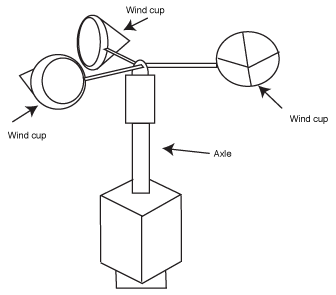Weather: The Wind in the Willows
The Wind in the Willows
When the atmospheric pressure varies between the horizontal points, the wind blows. As the English poet Christina Rossetti once wrote, "Who has seen the wind, neither I nor you." But that hasn't stopped us from measuring it. A wind vane is almost as old as the beginning of time. A simple pennant or flag will point in the direction from which the wind is coming. On airport runways, a cone-shaped bag opened at each end extends horizontally and points in the direction of the wind. This simple wind vane is called a windsock. Pilots can tell the wind direction as they land.
Weather-Speak
A pressure plate anemometer is the oldest type of anemometer. It measures wind speed by a single swinging metal plate rather than the cups of a modern anemometer.
Weather-Wise
An anemometer measures wind speed, while a weather vane or wind vane measures wind direction.
By the way and very importantly, the wind direction is never the direction the wind is going, but rather, the direction from which the wind is coming. A northeast wind is coming from the northeast. A south, or southerly, wind blows from the south.
What about wind speed? Again, back in the seventeenth century, English physicist Robert Hooke came up with a device consisting of a plate that moved proportionally to the wind speed. The plate swung out farther in a stronger wind. That became known as a pressure plate anemometer.
In more recent times, rotating cups mounted on a shaft have been used for measuring wind speeds (see the figure at the end). This cup anemometer records the wind speed as the cups spin. Those rotating cups might turn some gears or generate an electrical current. The greater current indicates higher wind speeds.
Some anemometers, called aerovanes, look like airplane propellers. The device swings into the wind, and then the propeller blades rotate with the increasing wind speed.
Something that easily beats an old rusty anemometer is the traditional Beaufort scale, which relates wind speeds to the motion of objects such as trees or water. Anemometers become inaccurate because of their constant exposure.
| Beaufort Number | Wind Speed Miles/hour (Km/hour) | Description |
|---|---|---|
| 0 | Calm: Still: Smoke will rise vertically. | |
| 1 | 1-3 (1.6-4.8) | Light Air: Rising smoke drifts, weather vane is inactive. |
| 2 | 4-7 (6.4-11.3) | Light Breeze: Leaves rustle, can feel wind on your face, weather vane is inactive. |
| 3 | 8-12 (12.9-19.3) | Gentle Breeze: Leaves and twigs move around. Light weight flags extend. |
| 4 | 13-18(20.9-29.0) | Moderate Breeze: Moves thin branches, raises dust and paper. |
| 5 | 19-24 (30.6-38.6) | Fresh Breeze: Moves trees sway. |
| 6 | 25-31(40.2-50.0) | Strong Breeze: Large tree branches move, open wires (such as telegraph wires) begin to "whistle," umbrellas are difficult to keep under control. |
| 7 | 32-38 (51.5-61.2) | Moderate Gale: Large trees begin to sway, noticeably difficult to walk. |
| 8 | 39-46(62.8-74.0) | Fresh Gale: Twigs and small branches are broken from trees, walking into the wind is very difficult. |
| 9 | 47-54(75.6-86.9) | Strong Gale: Slight damage occurs to buildings, shingles are blown off of roofs. |
| 10 | 55-63 (88.5-101.4) | Whole Gale: Large trees are uprooted, building damage is considerable. |
| 11 | 64-72 (103.0-115.9) | Storm: Extensive widespread damage. These typically occur only at sea, and rarely inland. |
| 12 | >73 (>115.9) | Hurricane: Extreme destruction. |
Beaufort scale.
* The Beaufort number is also referred to as a "Force" number, for example, "Force 10 Gale."
* To calculate knots, divide miles/hour by 1.15.
* Small craft advisories are usually issued when force 6 is reached.

Anemometer—wind speed instrument.

Excerpted from The Complete Idiot's Guide to Weather © 2002 by Mel Goldstein, Ph.D.. All rights reserved including the right of reproduction in whole or in part in any form. Used by arrangement with Alpha Books, a member of Penguin Group (USA) Inc.







